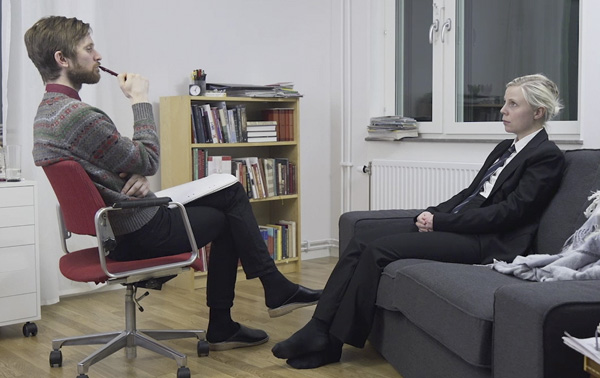Vernissage
fredag 14 november 2014 kl 17–22

Anna
Sörenson, “Therapy with a bureaucrat”, video still.
Vi tror på makt. Dagligen stöter vi på maktstrukturer
och vi betraktar maktföreteelser som naturliga ramar i vår
verklighet. Vi inser att vissa av oss har mer makt än andra, att
makt är någonting man i bästa fall får
tillfälligt men som också kan erövras. I alla fall
förväntar vi oss att makt skall vara knuten till ansvar och
skyldigheter, som om makt spontant skulle underordnas människans
förnuft och vilja. Men är det verkligen så det funkar?
I mina ögon är Makt huvudämnet i Anna Sörensons
konstnärliga projekt ”The Departments”. Sedan 2012 gör hon
performance (i Stockholm, Bryssel och Miami) där hon bjuder in
publiken att delta och lämna sitt bidrag till varje steg av ett
experiment, som i sin tur, efter analys, blir grunden till nästa
möte. Maktutövning kräver en rollfördelning och
blir därför ett också ett samarbete.
Fördelen med att iscensätta maktens mekanismer inom ramen av
en konstutställning, är att ingen människa behöver
ta skada av det. Men Anna Sörensons arbete belyser hur långt
en nästan vardaglig situation engagerar oss i maktens spel,
där varje aktör medvetet eller ej underordnar sig själva
makten.
Kom till Candyland och smaka på makten den 14 november!
Jean Ploteau
Anna Sörenson är född och uppvuxen i Stockholm. Hon tog
sin kandidatexamen vid Umeå Konsthögskola och sin
masterexamen vid Pratt Institute, New York, finansierad av Fulbright
Scholarship, 2012. Hon har precis avlagt en post-masterexamen vid
a.pass, en årslång fördjupning i performancekonst i
Bryssel, Belgien.
Hennes första separatutställning ägde rum 2012
på Ed Varie i New York och sen dess har hon ställt ut
i Stockholm, Bryssel, Berlin, New York och Miami. Anna Sörenson
bor och arbetar för tillfället i Stockholm.
www.annasorenson.se
Anna Sörenson är inbjuden av Jean Ploteau.
In English:
We believe in
power. Everyday we face power structures and we view them as natural
boundaries of reality. We realize that some of us have more power than
others, that power is something a lucky few get to have temporarily but
that power also can be captured. In any case we expect power to be tied
to responsibility and duty, that power would naturally subordinate the
human needs and sensibilities. But is it that really how power operates?
The main topic,
as I see it, in Anna Sörenson’s conceptual art piece “The
Departments” is power. Since 2012 has she staged her performance “Your
Application is Pending” (in Stockholm, Brussels, Miami) where she
invites the audience to take part and with their contribution they
themselves lay the ground for the logic of the procedure and the
following analysis. To exercise power needs a clear set of roles and
therefore constitutes collaboration.
The advantage in
staging the mechanism of power in the context of an art exhibition is
that no one will be hurt. But Anna Sörenson’s work shreds light on
how something that looks like a ordinary situation truly engage us in a
power play, where every one who takes part is ordering themselves in
the power structure, whether he or she wants it or not.
Come and get a
taste of power at Candyland the 14th of November!
Jean Ploteau
Born and raised
in Stockholm, Anna Sörenson received her BFA from Umeå
University in Sweden. In 2012, Anna received her MFA from Pratt
Institute supported by her Fulbright Scholarship. 2014 she graduated
from a.pass, a yearlong post-master program in performance art in
Brussels, Belgium.
She assembled
her first solo exhibition in the fall of 2012, at Ed Varie in New York
City and has exhibited her work in Stockholm, Brussels, Berlin, New
York and Miami. She currently lives and works in Stockholm.
www.annasorenson.se
The Departments of Anna Sörenson
In December 2012 I opened The Departments. It began in Vermont during a
time when I travelled to and from the United States as a foreigner and
consequently experiencing numerous border control interviews. Passing
the border so often I began to analyse the content and the method of
the interviews in order to comprehend and to do better next time. I
feel that I came to understand the absurd logic of the interview, the
strict format and the method of indexing and classifying the
interviewee’s answers. Continue reading (pdf)